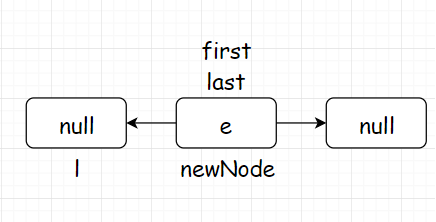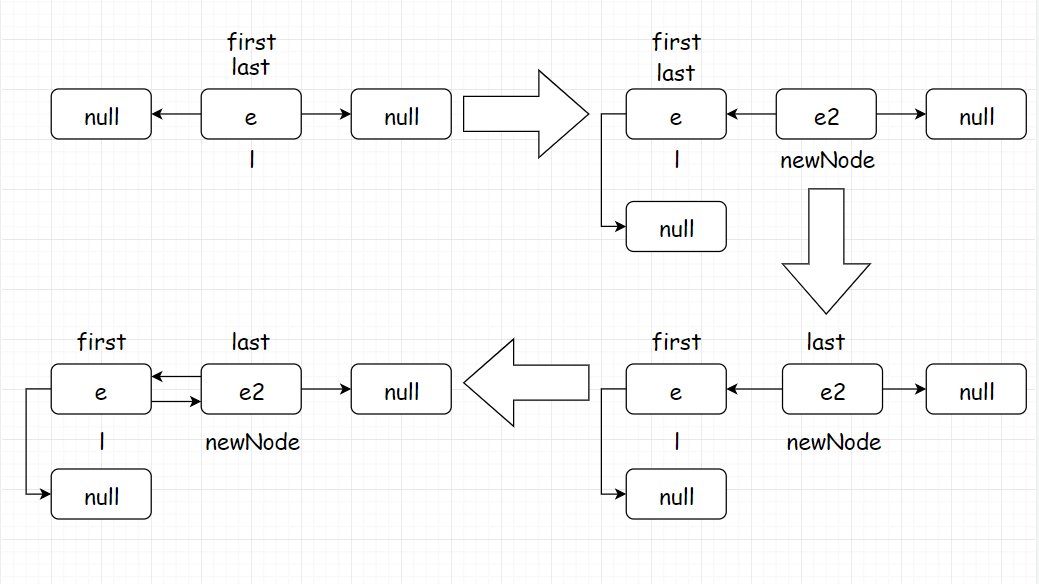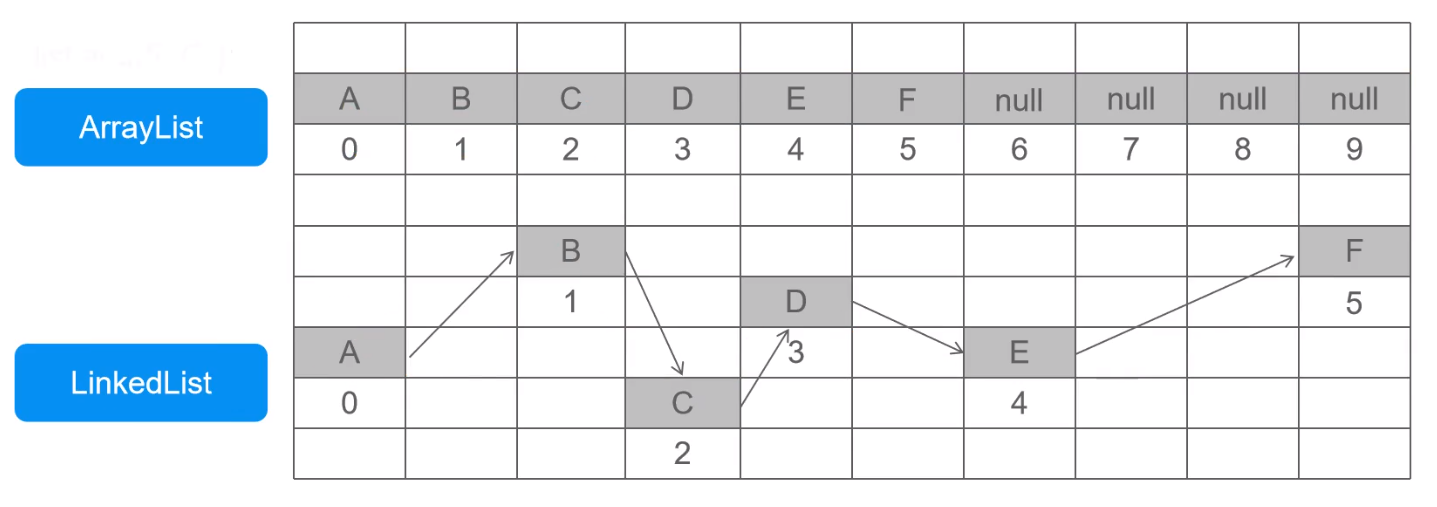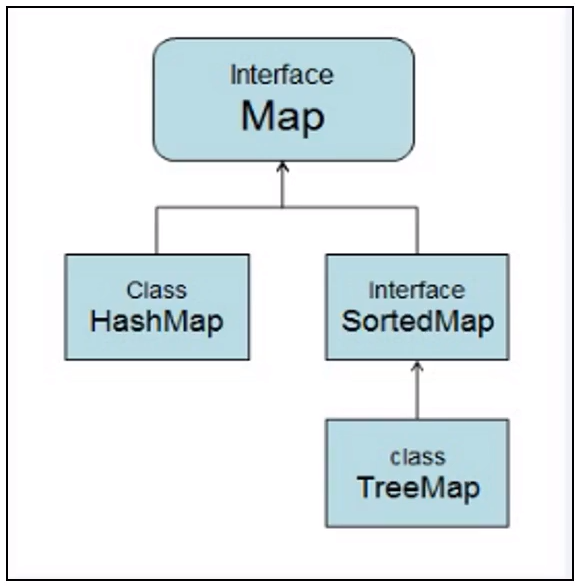集合
-
概念:对象的容器,定义了对多个对象进行操作的常用方法。可实现数组的功能。
-
和数组区别:
- (1)数组长度固定,集合长度不固定。
- (2)数组可以存储基本类型和引用类型,集合只能存储引用类型。
-
位置:java.util.*;
Collection体系集合

Collection父接口
-
特点:代表一组任意类型的对象,无序、无下标、不能重复。
-
方法:
boolean add(Object obj) //添加一个对象。boolean addAll(Collection c) //将一个集合中的所有对象添加到此集合中。void clear() //清空此集合中的所有对象。boolean contains(Object o) //检查此集合中是否包含o对象。boolean equals(Object o) //比较此集合是否与指定对象相等。boolean isEmpty() //判断此集合是否为空。boolean remove(Object o) //在此集合中移除o对象。int size() //返回此集合中的元素个数。Object[] toArray() //将此集合转换成数组。
package com.jack.collections_framework;
import java.util.ArrayList;
import java.util.Collection;
import java.util.Iterator;
/**
* Collection接口的使用(一)
* 1.添加元素
* 2.删除元素
* 3.遍历元素
* 4.判断
*/
public class Demo01 {
public static void main(String[] args) {
//创建集合
Collection collection = new ArrayList();
//1.添加元素
collection.add("苹果");
collection.add("西瓜");
collection.add("榴莲");
System.out.println("元素个数:" + collection.size());//元素个数:3
System.out.println(collection);//[苹果, 西瓜, 榴莲]
//2.删除元素
// collection.remove("榴莲");
// System.out.println("删除之后:" + collection);//删除之后:[苹果, 西瓜]
//清空
// collection.clear();
// System.out.println("删除之后:" + collection.size());//删除之后:0
//3.遍历元素[重点]
//3.1增强for
System.out.println("----------------3.1使用增强for--------------");
for (Object object : collection) {
System.out.println(object);
}
/*
苹果
西瓜
榴莲
*/
//3.2迭代器(迭代器专门用来遍历集合的一种方式)
System.out.println("----------------3.2使用迭代器--------------");
Iterator it = collection.iterator();
while(it.hasNext()){
String s = (String) it.next();
System.out.println(s);
/*
苹果
西瓜
榴莲
*/
//删除,不能使用collection删除方法
//it.remove();
}
//System.out.println("元素个数:" + collection.size());//元素个数:0
//4.判断
System.out.println(collection.contains("西瓜"));//true
System.out.println(collection.isEmpty());//false
}
}
package com.jack.collections_framework;
import java.util.ArrayList;
import java.util.Collection;
import java.util.Iterator;
/**
* Collection接口的使用(二)
*Collection使用:保存学生信息
*/
public class Demo02 {
public static void main(String[] args) {
//新建Collection对象
Collection collection = new ArrayList();
Student s1 = new Student("张三", 20);
Student s2 = new Student("李四", 18);
Student s3 = new Student("王五", 22);
//1.添加数据
collection.add(s1);
collection.add(s2);
collection.add(s3);
collection.add(s3);
System.out.println("元数个数:" + collection.size());//元数个数:4
System.out.println(collection);//[Student [name=张三,age=20], Student [name=李四,age=18], Student [name=王五,age=22], Student [name=王五,age=22]]
//2.删除
//collection.remove(s1);//删除之后:3
//collection.remove(new Student("张三",20));//并不能删除s1
//collection.clear();//删除之后:0
//System.out.println("删除之后:" + collection.size());
//3.遍历
//3.1增强for
for (Object object : collection) {
Student s = (Student) object;
System.out.println(s.toString());
}
/*
Student [name=张三,age=20]
Student [name=李四,age=18]
Student [name=王五,age=22]
Student [name=王五,age=22]
*/
//3.2迭代器,迭代过程中不能使用collection的删除方法
Iterator it = collection.iterator();
while (it.hasNext()){
Student s = (Student) it.next();
System.out.println(s.toString());
}
/*
Student [name=张三,age=20]
Student [name=李四,age=18]
Student [name=王五,age=22]
Student [name=王五,age=22]
*/
//4.判断
System.out.println(collection.contains(s1));//true
System.out.println(collection.isEmpty());//false
}
}
学生类:
package com.jack.collections_framework;
public class Student {
private String name;
private int age;
public Student() {
}
public Student(String name, int age) {
this.name = name;
this.age = age;
}
public String getName() {
return name;
}
public void setName(String name) {
this.name = name;
}
public int getAge() {
return age;
}
public void setAge(int age) {
this.age = age;
}
@Override
public String toString() {
return "Student [name=" + name + ",age=" + age +"]";
}
}
Collection子接口
List子接口
- 特点:有序、有下标、元素可以重复。
- 方法:
void add(int index,Object o) //在index位置插入对象o。boolean addAll(index,Collection c) //将一个集合中的元素添加到此集合中的index位置。Object get(int index) //返回集合中指定位置的元素。List subList(int fromIndex,int toIndex) //返回fromIndex和toIndex之间的集合元素。
package com.jack.collections_framework;
import java.util.ArrayList;
import java.util.Iterator;
import java.util.List;
import java.util.ListIterator;
/**
* List接口的使用(一)
* 特点:1.有序,有下标 2.可以重复
*/
public class Demo03 {
public static void main(String[] args) {
List list = new ArrayList<>();
//1.添加元素
list.add("苹果");
list.add("小米");
list.add(0,"华为");
System.out.println("元素个数:" + list.size());//元素个数:3
System.out.println(list);//[华为, 苹果, 小米]
//2.删除元素
// list.remove("苹果");
// list.remove(0);
// System.out.println("删除之后:" + list.size());//删除之后:1
// System.out.println(list.toString());//[小米]
//3.遍历
//3.1使用for遍历
System.out.println("--------------3.1使用for遍历--------------");
for (int i = 0; i < list.size(); i++) {
System.out.println(list.get(i));
}
/*
华为
苹果
小米
*/
//3.2增强for
System.out.println("--------------3.2增强for--------------");
for (Object object : list) {
System.out.println(object);
}
/*
华为
苹果
小米
*/
//3.3使用迭代器
System.out.println("--------------3.3使用迭代器--------------");
Iterator it = list.iterator();
while (it.hasNext()){
System.out.println(it.next());
}
/*
华为
苹果
小米
*/
//3.4使用列表迭代器,listIterator可以双向遍历,添加、删除及修改元素。
ListIterator lit = list.listIterator();
System.out.println("--------------3.4使用列表迭代器从前往后--------------");
while(lit.hasNext()){
System.out.println(lit.nextIndex() + ":" + lit.next());
}
/*
0:华为
1:苹果
2:小米
*/
System.out.println("--------------3.4使用列表迭代器从后往前--------------");
while(lit.hasPrevious()){
System.out.println(lit.previousIndex() + ":" + lit.previous());
}
/*
2:小米
1:苹果
0:华为
*/
//4.判断
System.out.println(list.contains("苹果"));//true
System.out.println(list.isEmpty());//false
//5.获取位置
System.out.println(list.indexOf("华为"));//0
}
}
package com.jack.collections_framework;
import java.util.ArrayList;
import java.util.List;
/**
* List接口的使用(二)
*/
public class Demo04 {
public static void main(String[] args) {
//创建集合
List list = new ArrayList();
//1.添加数字数据(自动装箱)
list.add(20);
list.add(30);
list.add(40);
list.add(50);
list.add(60);
System.out.println("元素个数:" + list.size());//元素个数:5
System.out.println(list);//[20, 30, 40, 50, 60]
//2.删除操作
// list.remove(0);//根据下标删除
// list.remove((Object)20);//根据对象删除
// list.remove(new Integer(20));//使用Integer删除
// System.out.println("删除后元素个数:" + list.size());//删除后元素个数:4
//3.补充方法subList(int fromIndex,int toIndex),返回fromIndex和toIndex之间的集合元素。
List subList = list.subList(1, 3);
System.out.println(subList);//[30, 40]
}
}
List实现类
ArrayList【重点】
- 数组结构实现,查询块、增删慢;
- JDK1.2版本,运行效率快、线程不安全。
package com.jack.collections_framework;
import java.util.ArrayList;
import java.util.Iterator;
import java.util.ListIterator;
/**
* ArrayList的使用
* 存储结构:数组,查找遍历比较快,增删慢
* 1.添加元素
* 2.删除元素
* 3.遍历元素
* 4.判断
* 5.查找
*/
public class Demo05 {
public static void main(String[] args) {
//创建集合
ArrayList arrayList = new ArrayList<>();
Student s1 = new Student("刘德华",20);
Student s2 = new Student("梁朝伟",22);
Student s3 = new Student("郭富城",18);
//1.添加元素
arrayList.add(s1);
arrayList.add(s2);
arrayList.add(s3);
System.out.println("元素个数:" + arrayList.size());//元素个数:3
System.out.println(arrayList);//[Student [name=刘德华,age=20], Student [name=梁朝伟,age=22], Student [name=郭富城,age=18]]
//2.删除元素
// arrayList.remove(s1);
// arrayList.remove(new Student("刘德华",20));
// System.out.println("删除之后元素个数:" + arrayList.size());//删除之后元素个数:2 (Student类已重写equals方法)
//3.遍历元素【重点】
//for遍历和增强for省略
//3.1使用迭代器
Iterator it = arrayList.iterator();
while (it.hasNext()){
Student s = (Student) it.next();
System.out.println(s.toString());
}
/*
Student [name=刘德华,age=20]
Student [name=梁朝伟,age=22]
Student [name=郭富城,age=18]
*/
//3.2列表迭代器
ListIterator lit = arrayList.listIterator();
System.out.println("-----------------3.2列表迭代器从前往后----------------");
while(lit.hasNext()){
Student s = (Student) lit.next();
System.out.println(s.toString());
}
/*
Student [name=刘德华,age=20]
Student [name=梁朝伟,age=22]
Student [name=郭富城,age=18]
*/
System.out.println("-----------------3.2列表迭代器从后往前----------------");
while(lit.hasPrevious()){
Student s = (Student) lit.previous();
System.out.println(s.toString());
}
/*
Student [name=郭富城,age=18]
Student [name=梁朝伟,age=22]
Student [name=刘德华,age=20]
*/
//4.判断
System.out.println(arrayList.contains(new Student("梁朝伟",22)));//true,因为已重写equals方法,没有重写则为false
System.out.println(arrayList.isEmpty());//false
//5.查找
System.out.println(arrayList.indexOf(new Student("梁朝伟",22)));//1,因为已重写equals方法,没有重写则为-1
}
}
注:Object里的equals(this==obj)用地址和当前对象比较,如果想实现代码中的问题,可以在学生类中重写equals方法:
@Override
public boolean equals(Object obj) {
//1.是否为同一对象
if (this==obj) {
return true;
}
//2.判断是否为空
if (obj==null) {
return false;
}
//3.判断是否是Student类型
if (obj instanceof Student) {
Student student=(Student) obj;
//4.比较属性
if(this.name.equals(student.getName())&&this.age==student.age) {
return true;
}
}
//不满足,返回false
return false;
}
ArrayList源码分析
-
默认容量大小:
private static final int DEFAULT_CAPACITY = 10; -
存放元素的数组:
transient Object[] elementData; -
实际元素个数:
private int size; -
创建对象时调用的无参构造函数:
//这是一个空的数组 private static final Object[] DEFAULTCAPACITY_EMPTY_ELEMENTDATA = {}; public ArrayList() { this.elementData = DEFAULTCAPACITY_EMPTY_ELEMENTDATA; }这段源码说明当你没有向集合中添加任何元素时,集合容量为0。那么默认的10个容量怎么来的呢?
这就得看看add方法的源码了:
public boolean add(E e) { ensureCapacityInternal(size + 1); // Increments modCount!! elementData[size++] = e; return true; }假设你new了一个数组,当前容量为0,size当然也为0。这时调用add方法进入到
ensureCapacityInternal(size + 1);该方法源码如下:private void ensureCapacityInternal(int minCapacity) { ensureExplicitCapacity(calculateCapacity(elementData, minCapacity)); }该方法中的参数minCapacity传入的值为size+1也就是 1,接着我们再进入到
calculateCapacity(elementData, minCapacity)里面:private static int calculateCapacity(Object[] elementData, int minCapacity) { if (elementData == DEFAULTCAPACITY_EMPTY_ELEMENTDATA) { return Math.max(DEFAULT_CAPACITY, minCapacity); } return minCapacity; }上文说过,elementData就是存放元素的数组,当前容量为0,if条件成立,返回默认容量
DEFAULT_CAPACITY也就是10。这个值作为参数又传入ensureExplicitCapacity()方法中,进入该方法查看源码:private void ensureExplicitCapacity(int minCapacity) { modCount++; // overflow-conscious code if (minCapacity - elementData.length > 0) grow(minCapacity); }我们先不要管modCount这个变量。因为elementData数组长度为0,所以if条件成立,调用grow方法,重要的部分来了,我们再次进入到grow方法的源码中:
private void grow(int minCapacity) { // overflow-conscious code int oldCapacity = elementData.length; int newCapacity = oldCapacity + (oldCapacity >> 1); if (newCapacity - minCapacity < 0) newCapacity = minCapacity; if (newCapacity - MAX_ARRAY_SIZE > 0) newCapacity = hugeCapacity(minCapacity); // minCapacity is usually close to size, so this is a win: elementData = Arrays.copyOf(elementData, newCapacity); }这个方法先声明了一个oldCapacity变量将数组长度赋给它,其值为0;又声明了一个newCapacity变量其值为
oldCapacity+一个增量,可以发现这个增量是和原数组长度有关的量,当然在这里也为0。第一个if条件满足,newCapacity的值为10(这就是默认的容量,不理解的话再看看前面)。第二个if条件不成立,也可以不用注意,因为MAX_ARRAY_SIZE的定义如下:private static final int MAX_ARRAY_SIZE = Integer.MAX_VALUE - 8;这个值太大了以至于第二个if条件没有了解的必要。
最后一句话就是为elementData数组赋予了新的长度,
Arrays.copyOf()方法返回的数组是新的数组对象,原数组对象不会改变,该拷贝不会影响原来的数组。copyOf()的第二个自变量指定要建立的新数组长度,如果新数组的长度超过原数组的长度,则保留数组默认值。这时候再回到add的方法中,接着就向下执行
elementData[size++] = e;到这里为止关于ArrayList就讲解得差不多了,当数组长度为10的时候你们可以试着过一下源码,查一下每次的增量是多少(答案是每次扩容为原来的1.5倍)。
Vector
-
数组结构实现,查询快、增删慢;
-
JDK1.0版本,运行效率慢、线程安全。
import java.util.Enumeration; import java.util.Vector; /** * Vector的演示使用 * 存储结构:数组 *1.添加数据 *2.删除数据 *3.遍历 *4.判断 */ public class Demo06 { public static void main(String[] args) { Vector vector=new Vector<>(); //1.添加数据 vector.add("草莓"); vector.add("糖果"); vector.add("西瓜"); System.out.println("元素个数:"+vector.size());//元素个数:3 //2.删除数据 // vector.remove(0); // vector.remove("西瓜"); //清空 // vector.clear(); //3.遍历 //使用枚举器 Enumeration enumeration=vector.elements(); while (enumeration.hasMoreElements()) { String s = (String) enumeration.nextElement(); System.out.println(s); } /* 草莓 糖果 西瓜 */ //4.判断 System.out.println(vector.isEmpty());//false System.out.println(vector.contains("西瓜"));//true //5. Vector其他方法 //firstElement();//返回第一个。 //lastElement();//返回最后一个。 //ElementAt(int index);//返回指定索引处的组件。 } }
LinkedList
- 链表结构实现,增删快,查询慢。
import java.util.Iterator;
import java.util.LinkedList;
import java.util.ListIterator;
/**
* LinkedList的用法
* 存储结构:双向链表
* 1.添加元素
* 2.删除元素
* 3.遍历
* 4.判断
*/
public class Demo07 {
public static void main(String[] args) {
LinkedList linkedList=new LinkedList<>();
Student s1=new Student("刘德华", 20);
Student s2=new Student("郭富城", 22);
Student s3=new Student("梁朝伟", 18);
//1.添加元素
linkedList.add(s1);
linkedList.add(s2);
linkedList.add(s3);
System.out.println("元素个数:"+linkedList.size());//元素个数:3
System.out.println(linkedList.toString());//[Student [name=刘德华,age=20], Student [name=郭富城,age=22], Student [name=梁朝伟,age=18]]
//2.删除元素
// linkedList.remove(s1);
// linkedList.remove(new Student("刘德华", 20));
// System.out.println(linkedList.toString());
//3.遍历
//3.1 使用for
for(int i=0;i<linkedList.size();++i) {
System.out.println(linkedList.get(i));
}
//3.2 使用增强for
for(Object object:linkedList) {
Student student=(Student) object;
System.out.println(student.toString());
}
//3.3 使用迭代器
Iterator it =linkedList.iterator();
while (it.hasNext()) {
Student student = (Student) it.next();
System.out.println(student.toString());
}
//3.4 使用列表迭代器,逆序省略
ListIterator lit = linkedList.listIterator();
while (lit.hasNext()){
Student student = (Student) lit.next();
System.out.println(student.toString());
}
//4. 判断
System.out.println(linkedList.contains(s1));
System.out.println(linkedList.isEmpty());
//5.获取
System.out.println(linkedList.indexOf(s3));
}
}
LinkedList源码分析
LinkedList首先有三个属性:
- 链表大小:
transient int size = 0; - (指向)第一个结点/头结点:
transient Node<E> first; - (指向)最后一个结点/尾结点:
transient Node<E> last;
关于Node类型我们再进入到类里看看:
private static class Node<E> {
E item;
Node<E> next;
Node<E> prev;
Node(Node<E> prev, E element, Node<E> next) {
this.item = element;
this.next = next;
this.prev = prev;
}
}
首先item存放的是实际数据;next指向下一个结点而prev指向上一个结点。
Node带参构造方法的三个参数分别是前一个结点、存储的数据、后一个结点,调用这个构造方法时将它们赋值给当前对象。
LinkedList是如何添加元素的呢?先看看add方法:
public boolean add(E e) {
linkLast(e);
return true;
}
进入到linkLast方法:
void linkLast(E e) {
final Node<E> l = last;
final Node<E> newNode = new Node<>(l, e, null);
last = newNode;
if (l == null)
first = newNode;
else
l.next = newNode;
size++;
modCount++;
}
假设刚开始new了一个LinkedList对象,first和last属性都为空,调用add进入到linkLast方法。
首先创建一个Node变量 l 将last(此时为空)赋给它,然后new一个newNode变量存储数据,并且它的前驱指向l,后继指向null;再把last指向newNode。如下图所示:

如果满足if条件,说明这是添加的第一个结点,将first指向newNode:

至此,LinkedList对象的第一个数据添加完毕。假设需要再添加一个数据,我们可以再来走一遍,过程同上不再赘述,图示如下:

ArrayList和LinkedList区别
- ArrayList:必须开辟连续空间,查询快,增删慢。
- LinkedList:无需开辟连续空间,查询慢,增删快。

泛型概述
- Java泛型是JDK1.5中引入的一个新特性,其本质是参数化类型,把类型作为参数传递。
- 常见形式有泛型类、泛型接口、泛型方法。
- 语法:
- <T,…> T称为类型占位符,表示一种引用类型。
- 好处:
- 提高代码的重用性。
- 防止类型转换异常,提高代码的安全性。泛型概述
- Java泛型是JDK1.5中引入的一个新特性,其本质是参数化类型,把类型作为参数传递。
- 常见形式有泛型类、泛型接口、泛型方法。
- 语法:
- <T,…> T称为类型占位符,表示一种引用类型。
- 好处:
- 提高代码的重用性。
- 防止类型转换异常,提高代码的安全性。
泛型类
/**
* 泛型类
* 语法:类名<T>
* T是类型占位符,表示一种引用类型,编写多个使用逗号隔开
*
*/
public class myGeneric<T>{
//1.创建泛型变量
//不能使用new来创建,因为泛型是不确定的类型,也可能拥有私密的构造方法。
T t;
//2.泛型作为方法的参数
public void show(T t) {
System.out.println(t);
}
//泛型作为方法的返回值
public T getT() {
return t;
}
}
/**
* 注意:
* 1.泛型只能使用引用类型
* 2.不同泛型类型的对象不能相互赋值
*/
public class testGeneric {
public static void main(String[] args) {
//使用泛型类创建对象
myGeneric<String> myGeneric1=new myGeneric<String>();
myGeneric1.t="tang";
myGeneric1.show("he");
myGeneric<Integer> myGeneric2=new myGeneric<Integer>();
myGeneric2.t=10;
myGeneric2.show(20);
Integer integer=myGeneric2.getT();
}
}
泛型接口
/**
* 泛型接口
* 语法:接口名<T>
* 注意:不能创建泛型静态常量
*/
public interface MyInterface<T> {
//创建常量
String nameString="tang";
T server(T t);
}
/**
* 实现接口时确定泛型类
*/
public class MyInterfaceImpl implements MyInterface<String>{
@Override
public String server(String t) {
System.out.println(t);
return t;
}
}
//测试
MyInterfaceImpl myInterfaceImpl=new MyInterfaceImpl();
myInterfaceImpl.server("xxx");
//xxx
/**
* 实现接口时不确定泛型类
*/
public class MyInterfaceImpl2<T> implements MyInterface<T>{
@Override
public T server(T t) {
System.out.println(t);
return t;
}
}
//测试
MyInterfaceImpl2<Integer> myInterfaceImpl2=new MyInterfaceImpl2<Integer>();
myInterfaceImpl2.server(2000);
//2000
泛型方法
/**
* 泛型方法
* 语法:<T> 返回类型
*/
public class MyGenericMethod {
public <T> void show(T t) {
System.out.println("泛型方法"+t);
}
}
//测试
MyGenericMethod myGenericMethod=new MyGenericMethod();
myGenericMethod.show("tang");
myGenericMethod.show(200);
myGenericMethod.show(3.14);
泛型集合
- 概念:参数化类型、类型安全的集合,强制集合元素的类型必须一致。
- 特点:
- 编译时即可检查,而非运行时抛出异常。
- 访问时,不必类型转换(拆箱)。
- 不同泛型指尖引用不能相互赋值,泛型不存在多态。
之前我们在创建LinkedList类型对象的时候并没有使用泛型,但是进到它的源码中会发现:
public class LinkedList<E>
extends AbstractSequentialList<E>
implements List<E>, Deque<E>, Cloneable, java.io.Serializable{//略}
它是一个泛型类,而我之前使用的时候并没有传递,说明java语法是允许的,这个时候传递的类型是Object类,虽然它是所有类的父类,可以存储任意的类型,但是在遍历、获取元素时需要原来的类型就要进行强制转换。这个时候就会出现一些问题,假如往链表里存储了许多不同类型的数据,在强转的时候就要判断每一个原来的类型,这样就很容易出现错误。
Set集合概述
Set子接口
- 特点:无序、无下标、元素不可重复。
- 方法:全部继承自Collection中的方法。
import java.util.HashSet;
import java.util.Iterator;
import java.util.Set;
/**
* 测试set接口的使用
*/
public class Demo01 {
public static void main(String[] args) {
//创建集合
Set<String> set = new HashSet<>();
//1.添加数据
set.add("苹果");
set.add("华为");
set.add("华为");
set.add("小米");
System.out.println("数据个数:" + set.size());
System.out.println(set);
// //2.删除数据
// set.remove("小米");
// System.out.println(set);
//3.遍历【重点】
//3.1使用增强for
System.out.println("------------增强for-------------");
for (String string : set) {
System.out.println(string);
}
//3.2使用迭代器
System.out.println("-------------使用迭代器-------------");
Iterator<String> it = set.iterator();
while(it.hasNext()){
System.out.println(it.next());
}
//4.判断
System.out.println(set.contains("华为"));
System.out.println(set.isEmpty());
}
}
HashSet【重点】
- 基于HashCode计算元素存放位置。
- 当存入元素的哈希码相同时,会调用equals进行确认,如结果为true,则拒绝后者存入。
/**
* 人类
*/
public class Person {
private String name;
private int age;
public Person(String name,int age) {
this.name = name;
this.age = age;
}
public String getName() {
return name;
}
public void setName(String name) {
this.name = name;
}
public int getAge() {
return age;
}
public void setAge(int age) {
this.age = age;
}
@Override
public String toString() {
return "Peerson [name=" + name + ", age=" + age + "]";
}
}
/**
* HashSet集合的使用
* 存储结构:哈希表(数组+链表+红黑树)
* 1.添加元素
* 2.删除元素
* 3.遍历
* 4.判断
*/
public class Demo3 {
public static void main(String[] args) {
HashSet<Person> hashSet=new HashSet<>();
Person p1=new Person("tang",21);
Person p2=new Person("he", 22);
Person p3=new Person("yu", 21);
//1.添加元素
hashSet.add(p1);
hashSet.add(p2);
hashSet.add(p3);
//重复,添加失败
hashSet.add(p3);
//直接new一个相同属性的对象,依然会被添加,不难理解。
//假如相同属性便认为是同一个对象,怎么修改?
hashSet.add(new Person("yu", 21));
System.out.println(hashSet.toString());
//2.删除元素
hashSet.remove(p2);
//3.遍历
//3.1 增强for
for (Person person : hashSet) {
System.out.println(person);
}
//3.2 迭代器
Iterator<Person> iterator=hashSet.iterator();
while (iterator.hasNext()) {
System.out.println(iterator.next());
}
//4.判断
System.out.println(hashSet.isEmpty());
//直接new一个相同属性的对象结果输出是false,不难理解。
//注:假如相同属性便认为是同一个对象,该怎么做?
System.out.println(hashSet.contains(new Person("tang", 21)));
}
}
注:hashSet存储过程:
- 根据hashCode计算保存的位置,如果位置为空,则直接保存,否则执行第二步。
- 执行equals方法,如果方法返回true,则认为是重复,拒绝存储,否则形成链表。
存储过程实际上就是重复依据,要实现“注”里的问题,可以重写hashCode和equals代码:
@Override
public int hashCode() {
final int prime = 31;
int result = 1;
result = prime * result + age;
result = prime * result + ((name == null) ? 0 : name.hashCode());
return result;
}
@Override
public boolean equals(Object obj) {
if (this == obj)
return true;
if (obj == null)
return false;
if (getClass() != obj.getClass())
return false;
Person other = (Person) obj;
if (age != other.age)
return false;
if (name == null) {
if (other.name != null)
return false;
} else if (!name.equals(other.name))
return false;
return true;
}
hashCode方法里为什么要使用31这个数字大概有两个原因:
- 31是一个质数,这样的数字在计算时可以尽量减少散列冲突。
- 可以提高执行效率,因为31*i=(i<<5)-i,31乘以一个数可以转换成移位操作,这样能快一点;但是也有网上一些人对这两点提出质疑。
TreeSet
- 基于排序顺序实现不重复。
- 实现了SortedSet接口,对集合元素自动排序。
- 元素对象的类型必须实现Comparable接口,指定排序规则。
- 通过CompareTo方法确定是否为重复元素。
/**
* 使用TreeSet保存数据
* 存储结构:红黑树
* 要求:元素类必须实现Comparable接口,compareTo方法返回0,认为是重复元素
*/
public class Demo4 {
public static void main(String[] args) {
TreeSet<Person> persons=new TreeSet<Person>();
Person p1=new Person("tang",21);
Person p2=new Person("he", 22);
Person p3=new Person("yu", 21);
//1.添加元素
persons.add(p1);
persons.add(p2);
persons.add(p3);
//注:直接添加会报类型转换错误,需要实现Comparable接口
System.out.println(persons.toString());
//2.删除元素
persons.remove(p1);
persons.remove(new Person("he", 22));
System.out.println(persons.toString());
//3.遍历(略)
//4.判断
System.out.println(persons.contains(new Person("yu", 21)));
}
}
查看Comparable接口的源码,发现只有一个compareTo抽象方法,在人类中实现它:
public class Person implements Comparable<Person>{
@Override
//1.先按姓名比
//2.再按年龄比
public int compareTo(Person o) {
int n1=this.getName().compareTo(o.getName());
int n2=this.age-o.getAge();
return n1==0?n2:n1;
}
}
除了实现Comparable接口里的比较方法,TreeSet也提供了一个带比较器Comparator的构造方法,使用匿名内部类来实现它:
/**
* TreeSet的使用
* Comparator:实现定制比较(比较器)
*/
public class Demo5 {
public static void main(String[] args) {
TreeSet<Person> persons=new TreeSet<Person>(new Comparator<Person>() {
@Override
public int compare(Person o1, Person o2) {
// 先按年龄比较
// 再按姓名比较
int n1=o1.getAge()-o2.getAge();
int n2=o1.getName().compareTo(o2.getName());
return n1==0?n2:n1;
}
});
Person p1=new Person("tang",21);
Person p2=new Person("he", 22);
Person p3=new Person("yu", 21);
persons.add(p1);
persons.add(p2);
persons.add(p3);
System.out.println(persons.toString());
}
}
接下来我们来做一个小案例:
/**
* 要求:使用TreeSet集合实现字符串按照长度进行排序
* helloworld tangrui hechengyang wangzixu yuguoming
* Comparator接口实现定制比较
*/
public class Demo6 {
public static void main(String[] args) {
TreeSet<String> treeSet=new TreeSet<String>(new Comparator<String>() {
@Override
//先比较字符串长度
//再比较字符串
public int compare(String o1, String o2) {
int n1=o1.length()-o2.length();
int n2=o1.compareTo(o2);
return n1==0?n2:n1;
}
});
treeSet.add("helloworld");
treeSet.add("tangrui");
treeSet.add("hechenyang");
treeSet.add("yuguoming");
treeSet.add("wangzixu");
System.out.println(treeSet.toString());
//输出[tangrui, wangzixu, yuguoming, hechenyang, helloworld]
}
}
Map体系集合
-
Map接口的特点:
- 用于存储任意键值对(Key-Value)。
- 键:无序、无下标、不允许重复(唯一)。
- 值:无序、无下标、允许重复。

Map集合概述
- 特点:存储一对数据(Key-Value),无序、无下标,键不可重复。
- 方法:
V put(K key,V value)//将对象存入到集合中,关联键值。key重复则覆盖原值。
Object get(Object key)//根据键获取相应的值。Set<K>//返回所有的keyCollection<V> values()//返回包含所有值的Collection集合。Set<Map.Entry<K,V>>//键值匹配的set集合
/**
* Map接口的使用
* 特点:1.存储键值对 2.键不能重复,值可以重复 3.无序
*/
public class Demo1 {
public static void main(String[] args) {
Map<String,Integer> map=new HashMap<String, Integer>();
//1.添加元素
map.put("tang", 21);
map.put("he", 22);
map.put("fan", 23);
System.out.println(map.toString());
//2.删除元素
map.remove("he");
System.out.println(map.toString());
//3.遍历
//3.1 使用keySet();
for (String key : map.keySet()) {
System.out.println(key+" "+map.get(key));
}
//3.2 使用entrySet();效率较高
for (Map.Entry<String, Integer> entry : map.entrySet()) {
System.out.println(entry.getKey()+" "+entry.getValue());
}
}
}
Map集合的实现类
HashMap【重点】
-
JDK1.2版本,线程不安全,运行效率快;允许用null作为key或是value。
/** * 学生类 */ public class Student { private String name; private int id; public Student(String name, int id) { super(); this.name = name; this.id = id; } public String getName() { return name; } public void setName(String name) { this.name = name; } public int getId() { return id; } public void setId(int id) { this.id = id; } @Override public String toString() { return "Student [name=" + name + ", age=" + id + "]"; } }/** * HashMap的使用 * 存储结构:哈希表(数组+链表+红黑树) */ public class Demo2 { public static void main(String[] args) { HashMap<Student, String> hashMap=new HashMap<Student, String>(); Student s1=new Student("tang", 36); Student s2=new Student("yu", 101); Student s3=new Student("he", 10); //1.添加元素 hashMap.put(s1, "成都"); hashMap.put(s2, "杭州"); hashMap.put(s3, "郑州"); //添加失败,但会更新值 hashMap.put(s3,"上海"); //添加成功,不过两个属性一模一样; //注:假如相同属性便认为是同一个对象,怎么修改? hashMap.put(new Student("he", 10),"上海"); System.out.println(hashMap.toString()); //2.删除元素 hashMap.remove(s3); System.out.println(hashMap.toString()); //3.遍历 //3.1 使用keySet()遍历 for (Student key : hashMap.keySet()) { System.out.println(key+" "+hashMap.get(key)); } //3.2 使用entrySet()遍历 for (Entry<Student, String> entry : hashMap.entrySet()) { System.out.println(entry.getKey()+" "+entry.getValue()); } //4.判断 //注:同上 System.out.println(hashMap.containsKey(new Student("he", 10))); System.out.println(hashMap.containsValue("成都")); } }注:和之前说过的HashSet类似,重复依据是hashCode和equals方法,重写即可:
@Override public int hashCode() { final int prime = 31; int result = 1; result = prime * result + id; result = prime * result + ((name == null) ? 0 : name.hashCode()); return result; } @Override public boolean equals(Object obj) { if (this == obj) return true; if (obj == null) return false; if (getClass() != obj.getClass()) return false; Student other = (Student) obj; if (id != other.id) return false; if (name == null) { if (other.name != null) return false; } else if (!name.equals(other.name)) return false; return true; }
HashMap源码分析
-
默认初始化容量:
static final int DEFAULT_INITIAL_CAPACITY = 1 << 4; // aka 16- 数组最大容量:
static final int MAXIMUM_CAPACITY = 1 << 30;
- 数组最大容量:
-
默认加载因子:
static final float DEFAULT_LOAD_FACTOR = 0.75f; -
链表调整为红黑树的链表长度阈值(JDK1.8):
static final int TREEIFY_THRESHOLD = 8; -
红黑树调整为链表的链表长度阈值(JDK1.8):
static final int UNTREEIFY_THRESHOLD = 6; -
链表调整为红黑树的数组最小阈值(JDK1.8):
static final int MIN_TREEIFY_CAPACITY = 64; -
HashMap存储的数组:
transient Node<K,V>[] table; -
HashMap存储的元素个数:
transient int size;- 默认加载因子是什么?
- 就是判断数组是否扩容的一个因子。假如数组容量为100,如果HashMap的存储元素个数超过了100*0.75=75,那么就会进行扩容。
- 链表调整为红黑树的链表长度阈值是什么?
- 假设在数组中下标为3的位置已经存储了数据,当新增数据时通过哈希码得到的存储位置又是3,那么就会在该位置形成一个链表,当链表过长时就会转换成红黑树以提高执行效率,这个阈值就是链表转换成红黑树的最短链表长度;
- 红黑树调整为链表的链表长度阈值是什么?
- 当红黑树的元素个数小于该阈值时就会转换成链表。
- 链表调整为红黑树的数组最小阈值是什么?
- 并不是只要链表长度大于8就可以转换成红黑树,在前者条件成立的情况下,数组的容量必须大于等于64才会进行转换。
HashMap的数组table存储的就是一个个的Node<K,V>类型,很清晰地看到有一对键值,还有一个指向next的指针(以下只截取了部分源码):
static class Node<K,V> implements Map.Entry<K,V> { final K key; V value; Node<K,V> next; }之前的代码中在new对象时调用的是HashMap的无参构造方法,进入到该构造方法的源码查看一下:
public HashMap() { this.loadFactor = DEFAULT_LOAD_FACTOR; // all other fields defaulted }发现没什么内容,只是赋值了一个默认加载因子;而在上文我们观察到源码中table和size都没有赋予初始值,说明刚创建的HashMap对象没有分配容量,并不拥有默认的16个空间大小,这样做的目的是为了节约空间,此时table为null,size为0。
当我们往对象里添加元素时调用put方法:
public V put(K key, V value) { return putVal(hash(key), key, value, false, true); }put方法把key和value传给了putVal,同时还传入了一个hash(Key)所返回的值,这是一个产生哈希值的方法,再进入到putVal方法(部分源码):
final V putVal(int hash, K key, V value, boolean onlyIfAbsent, boolean evict) { Node<K,V>[] tab; Node<K,V> p; int n, i; if ((tab = table) == null || (n = tab.length) == 0) n = (tab = resize()).length; if ((p = tab[i = (n - 1) & hash]) == null) tab[i] = newNode(hash, key, value, null); else{ //略 } }这里面创建了一个tab数组和一个Node变量p,第一个if实际是判断table是否为空,而我们现在只关注刚创建HashMap对象时的状态,此时tab和table都为空,满足条件,执行内部代码,这条代码其实就是把resize()所返回的结果赋给tab,n就是tab的长度,resize顾名思义就是重新调整大小。查看resize()源码(部分):
final Node<K,V>[] resize() { Node<K,V>[] oldTab = table; int oldCap = (oldTab == null) ? 0 : oldTab.length; int oldThr = threshold; if (oldCap > 0); else if (oldThr > 0); else { // zero initial threshold signifies using defaults newCap = DEFAULT_INITIAL_CAPACITY; newThr = (int)(DEFAULT_LOAD_FACTOR * DEFAULT_INITIAL_CAPACITY); } @SuppressWarnings({"rawtypes","unchecked"}) Node<K,V>[] newTab = (Node<K,V>[])new Node[newCap]; table = newTab; return newTab; }该方法首先把table及其长度赋值给oldTab和oldCap;threshold是阈值的意思,此时为0,所以前两个if先不管,最后else里newCap的值为默认初始化容量16;往下创建了一个newCap大小的数组并将其赋给了table,刚创建的HashMap对象就在这里获得了初始容量。然后我们再回到putVal方法,第二个if就是根据哈希码得到的tab中的一个位置是否为空,为空便直接添加元素,此时数组中无元素所以直接添加。至此HashMap对象就完成了第一个元素的添加。当添加的元素超过16*0.75=12时,就会进行扩容:
final V putVal(int hash, K key, V value, boolean onlyIfAbsent,boolean evict){ if (++size > threshold) resize(); }扩容的代码如下(部分):
final Node<K,V>[] resize() { int oldCap = (oldTab == null) ? 0 : oldTab.length; int newCap; if (oldCap > 0) { if (oldCap >= MAXIMUM_CAPACITY) {//略} else if ((newCap = oldCap << 1) < MAXIMUM_CAPACITY && oldCap >= DEFAULT_INITIAL_CAPACITY) } }核心部分是else if里的移位操作,也就是说每次扩容都是原来大小的两倍。
- 默认加载因子是什么?
-
注:额外说明的一点是在JDK1.8以前链表是头插入,JDK1.8以后链表是尾插入。
HashSet源码分析
了解完HashMap之后,再回过头来看之前的HashSet源码,为什么放在后面写你们看一下源码就知道了(部分):
public class HashSet<E>
extends AbstractSet<E>
implements Set<E>, Cloneable, java.io.Serializable
{
private transient HashMap<E,Object> map;
private static final Object PRESENT = new Object();
public HashSet() {
map = new HashMap<>();
}
}
可以看见HashSet的存储结构就是HashMap,那它的存储方式是怎样的呢?可以看一下add方法:
public boolean add(E e) {
return map.put(e, PRESENT)==null;
}
很明了地发现它的add方法调用的就是map的put方法,把元素作为map的key传进去的。。
Hashtable
-
JDK1.0版本,线程安全,运行效率慢;不允许null作为key或是value。
-
初始容量11,加载因子0.75。
这个集合在开发过程中已经不用了,稍微了解即可。
Properties
-
Hashtable的子类,要求key和value都是String。通常用于配置文件的读取。
它继承了Hashtable的方法,与流关系密切,此处不详解。
TreeMap
- 实现了SortedMap接口(是Map的子接口),可以对key自动排序。
/**
* TreeMap的使用
* 存储结构:红黑树
*/
public class Demo3 {
public static void main(String[] args) {
TreeMap<Student, Integer> treeMap=new TreeMap<Student, Integer>();
Student s1=new Student("tang", 36);
Student s2=new Student("yu", 101);
Student s3=new Student("he", 10);
//1.添加元素
treeMap.put(s1, 21);
treeMap.put(s2, 22);
treeMap.put(s3, 21);
//不能直接打印,需要实现Comparable接口,因为红黑树需要比较大小
System.out.println(treeMap.toString());
//2.删除元素
treeMap.remove(new Student("he", 10));
System.out.println(treeMap.toString());
//3.遍历
//3.1 使用keySet()
for (Student key : treeMap.keySet()) {
System.out.println(key+" "+treeMap.get(key));
}
//3.2 使用entrySet()
for (Entry<Student, Integer> entry : treeMap.entrySet()) {
System.out.println(entry.getKey()+" "+entry.getValue());
}
//4.判断
System.out.println(treeMap.containsKey(s1));
System.out.println(treeMap.isEmpty());
}
}
在学生类中实现Comparable接口:
public class Student implements Comparable<Student>{
@Override
public int compareTo(Student o) {
int n1=this.id-o.id;
return n1;
}
除此之外还可以使用比较器来定制比较:
TreeMap<Student, Integer> treeMap2=new TreeMap<Student, Integer>(new Comparator<Student>() {
@Override
public int compare(Student o1, Student o2) {
// 略
return 0;
}
});
TreeSet源码
和HashSet类似,放在TreeMap之后讲便一目了然(部分):
public class TreeSet<E> extends AbstractSet<E>
implements NavigableSet<E>, Cloneable, java.io.Serializable
{
private transient NavigableMap<E,Object> m;
private static final Object PRESENT = new Object();
TreeSet(NavigableMap<E,Object> m) {
this.m = m;
}
public TreeSet() {
this(new TreeMap<E,Object>());
}
}
TreeSet的存储结构实际上就是TreeMap,再来看其存储方式:
public boolean add(E e) {
return m.put(e, PRESENT)==null;
}
它的add方法调用的就是TreeMap的put方法,将元素作为key传入到存储结构中。
Collections工具类
-
概念:集合工具类,定义了除了存取以外的集合常用方法。
-
方法:
public static void reverse(List<?> list)//反转集合中元素的顺序public static void shuffle(List<?> list)//随机重置集合元素的顺序public static void sort(List<T> list)//升序排序(元素类型必须实现Comparable接口)
/** * 演示Collections工具类的使用 * */ public class Demo4 { public static void main(String[] args) { List<Integer> list=new ArrayList<Integer>(); list.add(20); list.add(10); list.add(30); list.add(90); list.add(70); //sort排序 System.out.println(list.toString()); Collections.sort(list); System.out.println(list.toString()); System.out.println("---------"); //binarySearch二分查找 int i=Collections.binarySearch(list, 10); System.out.println(i); //copy复制 List<Integer> list2=new ArrayList<Integer>(); for(int i1=0;i1<5;++i1) { list2.add(0); } //该方法要求目标元素容量大于等于源目标 Collections.copy(list2, list); System.out.println(list2.toString()); //reserve反转 Collections.reverse(list2); System.out.println(list2.toString()); //shuffle 打乱 Collections.shuffle(list2); System.out.println(list2.toString()); //补充:list转成数组 Integer[] arr=list.toArray(new Integer[0]); System.out.println(arr.length); //补充:数组转成集合 String[] nameStrings= {"tang","he","yu"}; //受限集合,不能添加和删除 List<String> list3=Arrays.asList(nameStrings); System.out.println(list3); //注:基本类型转成集合时需要修改为包装类 } }





















 1621
1621











 被折叠的 条评论
为什么被折叠?
被折叠的 条评论
为什么被折叠?








